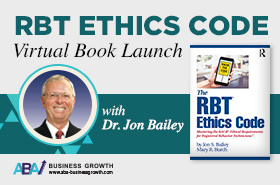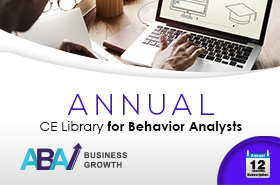2022 Ethics Code in Action with Dr. Jon Bailey: Ethics of RBT Turnover – 10 Staff (Recorded)
Original price was: $79.00.$69.00Current price is: $69.00.
In the field of Applied Behavior Analysis, the primary purpose of the Ethics Code is to protect consumers of ABA Services. In no other field of healthcare is living up to the standards established in an Ethics Code a goal that a group of certificants take as seriously. In fact, ethics is so important to the field of ABA that the BACB requires all BCBAs to obtain 4 Ethics CEUs during each certification renewal cycle. The only other field with mandatory Ethics CE requirement across the discipline is Speech and ASHA’s requirement of mandatory 1 Ethics CEU only went into effect in 2020.
LEVEL: Intermediate
Continuing Education Eligibility (Included):
2 BACB Learning CEU
2 (QABA®) General
2 APA CEU Eligibility
In the field of Applied Behavior Analysis, the primary purpose of the Ethics Code is to protect consumers of ABA Services. In no other field of healthcare is living up to the standards established in an Ethics Code a goal that a group of certificants take as seriously. In fact, ethics is so important to the field of ABA that the BACB requires all BCBAs to obtain 4 Ethics CEUs during each certification renewal cycle. The only other field with mandatory Ethics CE requirement across the discipline is Speech and ASHA’s requirement of mandatory 1 Ethics CEU only went into effect in 2020.
The evolution of the BACB and RBT Ethics Code as we know it today followed this path:
1999: Professional Disciplinary Standards
2001: Guideline for Responsible Conduct for Behavior Analysts
2002: 15-Hour Ethics Course Requirement for BCBA Applicants
2004: Guidelines for Responsible Conduct for Behavior Analysts (Updated)
2007: Ethics CEU Requirement Initiated
2010: Guidelines for Responsible Conduct for Behavior Analysts (Updated)
Professional Disciplinary and Ethical Standards (Updated)
2014: Professional and Ethical Compliance Code for Behavior Analysts
2015: 45-Hour Ethics Course Requirement for BCBA Applicants
2018: RBT Ethics Code
2022: Ethics Code for Behavior Analysts
RBT Ethics Code 2.0
The new Ethics Code for Behavior Analysts, which went into effect January 1, 2022, is an attempt by the BACB to provide better structure, guidance and ultimately, a decision-making framework for BCBAs and RBTs as compared to the “thou shalt not…” tone and tenor of the Professional and Ethical Compliance Code for Behavior Analysts.
The most significant changes to the 2022 Ethics Code for Behavior Analysts in terms of how practitioners are asked to evaluate their approach to providing care are additions of 1.07 Cultural Responsiveness and Diversity, 1.08 Nondiscrimination, and 1.10 Awareness of Personal Biases and Challenges. Interestingly enough, these topics have long been included in the Ethics Codes of other disciplines like Speech, Psychology, and Social Work, among others.
One seemingly minor, but significant modification is in gifting. 1.12 Giving and Receiving Gifts. BCBAs are now able to receive a gift with a monetary value under $10 US (or equivalent purchasing power in another currency) as long as the gifts do not become a
regularly expected source of income or value to the recipient.”
But if the true intent behind the Ethics Code is designed to protect consumers, then it should address the greatest barrier that is getting in the way of a clients’ ability to receive quality care. Pervasive lack of quality and continuity from poorly trained and supervised RBTs and 70%+ turnover among RBTs, forcing too many clients to receive fragmented services from multiple RBTs, a huge barrier to providing quality care.
What about the Ethics of RBT Turnover?
One of the biggest barriers to delivering quality services is turnover among direct care providers. Behavior Technicians or Registered Behavior Technicians (RBTs) perform a critical function – one of the most important functions – in the care delivery system. If BCBAs serve as the brain to develop quality programs, RBTs are the arms and legs required to implement these programs. And yet turnover among RBTs exceeds 70%! What are the impact on the client and his/her ability to make progress when there is no continuity of care?
Impact of RBT Turnover on ABA Organizations:
Turnover is very, very expensive. According to a conservative estimate by the Bureau of Labor Statistics, it costs $13,996 to replace an employee! This figure only includes measurable costs to the employer – recruiting, loss in billable hours, hiring, and training. That’s not even counting other factors like employee morale, corporate culture, etc.
Impact of RBT Turnover to Clients:
If consumer protection is the goal of the BCBA Ethics Code, why have we done nothing to break down the single greatest barrier to delivering quality care – RBT Turnover? Turnover stops clients from making progress because we lose valuable time. And NOBODY can get back the time that’s been stolen from the client. That’s time that could have been spent helping the client acquire new skills to increase their level of independence.
Even when a new (hopefully competent) RBT starts, there are hours of non-instruction time that have to be spent before the new RBT can begin to produce results. Time spent building rapport with the child, getting to know the parents, getting to know the supervisor, learning about the program, training, hours and hours of time spent– most of which is billed and reimbursed.
Impact of RBT Turnover on Parents:
STRESS! The level of stress a parent of a child with special needs faces daily is something that most people can’t even begin to understand. When you add to that the stress of managing your child during the inevitable waiting period, the process of onboarding a new RBT into your family, and learning to work with a new provider, the challenges add up quickly.
Impact of RBT Turnover on Funding Sources:
Who’s ultimately left paying for the cost of billable, non-productive time associated with getting a new RBT familiar with a new client? What about the opportunity cost of paying for hours of therapy for clients who might be able to transition out with no disruption in service when delivered by proficient, competent RBTs?
Impact of RBT Turnover on RBTs:
“My RBT credential just expired and I don’t care at all. I make a lot more working for tips.” – RBT
“RBTs are designed to be disposable, that’s the entire purpose of the position by design. You can’t have labor that’s designed to be cheap and quick to replace without companies treating them as if they’re cheap and quick to replace.” – RBT
Impact of RBT Turnover on BCBA Supervisor:
“I am leaving my current company to work for a company that pays RBTs and gives them full-time hours. I am taking less pay and losing a clinic director position for just a BCBA position. I am doing this because I could not stand taking away hours from my hard-working RBTs.” – BCBA
In this 2-hour webinar, Dr. Jon Bailey and Karen Chung, CEO of Special Learning, along with guest panelists, discussed the true cost of RBT Turnover.
The BACB created the RBT Credential in 2014 in response to requests from stakeholders, particularly funding sources looking for an official credentialed network of Behavior Technicians who implement ABA services. In 2013, there were nearly 40 states with autism insurance mandates, which necessitated the creation of a national credential for professionals whose work would need to be reimbursed by federal, state, and now private insurance companies to the tune of hundreds of billions of dollars.
Subject Matter Expert: Jon Bailey, Ph.D., BCBA-D and Karen Chung, CEO, Special Learning, Inc
Panelist: Amy Gable, BCBA, CEO, ABA Support Services
Learning Objectives:
- Describe the history of RBT Credential and its impact on key stakeholders
- List top 10 factors contributing to RBT Turnover
- Describe the impact of RBT Turnover among key stakeholder groups (Clients, Parents, RBTs, BCBAs, Organizations, Funding Sources)
- Compare and contrast different RBT employment HR models commonly in practice
- Explain employment models designed to increase RBT commitment and buy-in and reduce turnover.
- Discuss the pros and cons of implementing an RBT employment model that offers full-time salary and benefits to RBTs.
- Define an Ethical ABA organization.
- Explore systems-level contingencies that can be put in place to govern the behavior of unethical ABA organizations
The price includes 30-day access to the recording.
Purchases of 10 or more licenses include access to the recording for educational use for your whole team.
MANDATORY DISCLAIMER: The Behavior Analyst Certification Board (“BACB”) does not sponsor, approve or endorse ABA Business Growth, the materials, information, or sessions identified herein.
You may also like…
-
Holideals
RBT Ethics Code Virtual Book Launch with Dr. Jon Bailey, BCBA-D
Original price was: $79.00.$29.00Current price is: $29.00. Add to cart -
Full Business Solutions
Ethics of Compassionate Mandating Reporting Across Disciplines (Recorded)
$79.00 Add to cart -
Full Business Solutions
CE Library for Behavior Analysts
Original price was: $199.00.$159.00Current price is: $159.00. Add to cart








